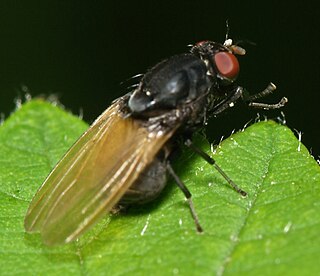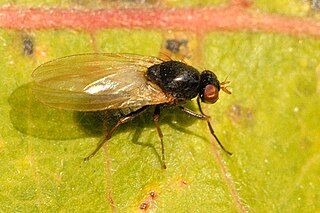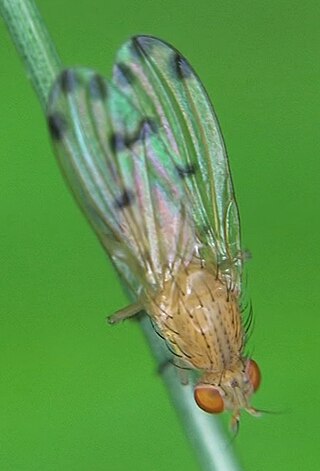
Francis Walker was an English entomologist. He was born in Southgate, London, on 31 July 1809 and died at Wanstead, England on 5 October 1874. He was one of the most prolific authors in entomology, and stirred controversy during his later life as his publications resulted in a huge number of junior synonyms. However, his assiduous work on the collections of the British Museum had great significance.

Alexander Henry Haliday was an Irish entomologist. He is primarily known for his work on Hymenoptera, Diptera, and Thysanoptera, but worked on all insect orders and on many aspects of entomology.

Cecidomyiidae is a family of flies known as gall midges or gall gnats. As the name implies, the larvae of most gall midges feed within plant tissue, creating abnormal plant growths called galls. Cecidomyiidae are very fragile small insects usually only 2–3 mm (0.079–0.118 in) in length; many are less than 1 mm (0.039 in) long. They are characterised by hairy wings, unusual in the order Diptera, and have long antennae. Some Cecidomyiids are also known for the strange phenomenon of paedogenesis in which the larval stage reproduces without maturing first. In some species, the daughter larvae consume the mother, while in others, reproduction occurs later on in the egg or pupa.

The Lauxanioidea are a superfamily of flies that includes the two large families, the Lauxaniidae and Chamaemyiidae, and the small family Celyphidae. Generally, they are small to medium, densely populated, coloured flies. The Chamaemyiidae live as parasites on insects. The family Celyphidae look like beetles.

The Lauxaniidae are a family of acalyptrate flies. They generally are small flies with large compound eyes that often are brightly coloured in life, sometimes with characteristic horizontal stripes, such as in Cestrotus species. Many species have variegated patterns on their wings, but in contrast they generally do not have variegated bodies, except for genera such as Cestrotus, whose camouflage mimics lichens or the texture of granitic rocks.

Chyromyidae are small to very small cyclorrhaphous, acalyptrate flies (Diptera) currently classified within the Heleomyzoidea by most authors. The majority have a pale yellow integument and bright iridescent green, red or purple eyes. The family is represented in all continents except Antarctica. There are about 150 named species in this family worldwide. There has been no comprehensive taxonomic study to elucidate the generic limits of species in the family. Currently, only four genera are recognised, but ongoing studies of the African species indicate that there are more.

Platypezidae is a family of true flies of the superfamily Platypezoidea. The more than 250 species are found worldwide primarily in woodland habitats. A common name is flat-footed flies, but this is also used for the closely related Opetiidae which were formerly included in the Platypezidae.

The Celyphidae, commonly known as beetle flies or beetle-backed flies, are a family of flies. About 115 species in about 9 genera are known chiefly from the Oriental and Afrotropic biogeographic regions with one lineage in the New World.

Linnaemya is a genus of flies in the family Tachinidae.

Minettia is a genus of small flies of the family Lauxaniidae. They have almost worldwide distribution, is one of the most species rich genera of the family with more than 120 described species. The Palaearctic is the most diverse with some 56 described species. The genus is divided into 3 subgenera.

Sapromyzosoma is a subgenus of small flies of the family Lauxaniidae.
Aulogastromyia is a genus of small flies of the family Lauxaniidae.

Tricholauxania is a genus of small flies of the family Lauxaniidae.

Calliopum is a genus of small flies of the family Lauxaniidae.

Meiosimyza is a genus of small flies of the family Lauxaniidae.

Meiosimyza rorida is a species of small flies of the family Lauxaniidae.
Meiosimyza platycephala is a species of small flies of the family Lauxaniidae.

Meiosimyza decempunctata is a species of small flies of the family Lauxaniidae.

Cheilosia psilophthalma is a Palearctic hoverfly closely related and very similar to Cheilosia latigenis, Cheilosia mutabilis and Cheilosia urbana . It is a rare and little known species recorded from Scandinavia, Ireland, Britain, France, Poland, Switzerland, Greece, Montenegro, Serbia, Ukraine and European Russia. Flowers visited include Acer platanoides, Anemone nemorosa, Primula veris, Prunus spinosa and Salix spp. Cheilosia psilophthalma flies in April and May. Open, grassy areas within sparse woodland and unimproved, montane subalpine grassland are preferred habitats. Larvae are recorded as developing in Hieracium pilosella and Hieracium caespitosum.
Chydaeopeza is a genus of flat-footed flies. There is one described species, Chydaeopeza tibialis.
















